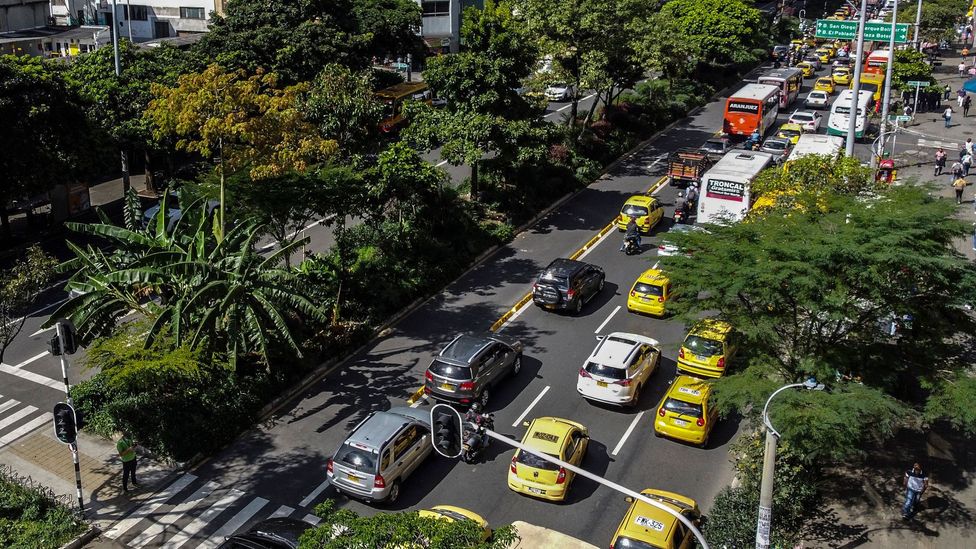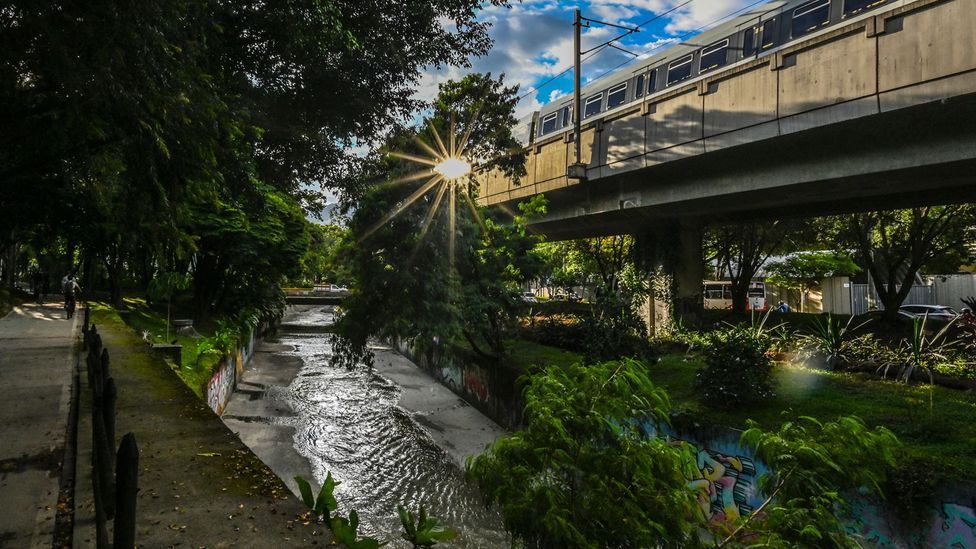He remembers a moment decades ago when the local government knocked down the trees lining the street as part of a traffic project.
Today, Oriental Avenue is still a typical large street filled with traffic and local commerce. But in a reversal of the previous decisions on local greenery, the area is now also covered with large fruit trees, shrubs and flowers. Castro says both the local air quality and temperature have improved.
The temperature here feels enjoyable all year and noticeably fresher than other areas in the city that do not have green cover. Bicycle paths line the streets and pedestrians rest on benches in the shade.
Sometimes referred to as the “City of Eternal Spring”, Medellín’s temperate climate has long helped attract tourists all year round, but increasing urbanisation had also exposed it to the urban heat island effect, where buildings and roads absorb and retain heat. Its new green corridors, however, have proven remarkably effective in reversing this impact, with a 2C temperature reduction across the city, according to local government data seen by BBC Future Planet.
Medellín, Colombia’s second largest city after Bogotá, started its “green corridors” programme in 2016 due to concern about air pollution and rising heat. Composed of more than 30 green corridors, it connects newly-greened road verges, vertical gardens, streams, parks and nearby hills. Initially the project involved planting some 120,000 individual plants and 12,500 trees on roads and in parks, with 2.5 million new smaller plants and 880,000 trees planted across the city by 2021. The idea was to connect green spaces in the city together through avenues and streets surrounded by trees and shade. The initial investment to establish the project cost a total of $16.3m (£13.2m) and annual maintenance cost $625,000 (£504,000) in 2022, according to the local government.
The project has now become well-known around the world due to its striking results in cooling the city. As well as reducing heat, experts say it holds promise in improving air quality and that it has brought back wildlife to the city.
At a time of rising concern about heatwaves linked to climate change, especially in cities, where the urban heat island affect can increase temperatures even more, Medellín’s approach to green corridors offers a low-cost, popular solution which other cities are increasingly looking to replicate. Could it be a model for a climate-resilient city of the future?

Green cover has helped lower temperatures on major highways such as Oriental Avenue in Medellín (Credit: Getty Images)
Alongside worries about urban heat, Medellín’s green corridors project was spurred into action due to concerns of poor air quality largely caused by a huge growth in private transport. The city’s location in the Aburrá Valley, a geographic formation that can trap pollution within its mountains, doesn’t help the situation. Climate and weather conditions are also unfavourable for the vertical dispersion of pollutants, says Maurício Correa, a researcher in environmental engineering at the University of Antioquia in Colombia.
According to IQair, a Swiss firm that measures air quality around the world, Medellín’s annual particulate matter (PM2.5) levels, while not the worst in South America, are three times the WHO guidelines for safe limits of maximum average 5µg/m3 over the year, and remain ahead of both Bogotá and São Paulo in Brazil. This pollution is far below some other cities well known for the problem – New Delhi measured at 18 times the WHO annual limit in 2022, for example.
However, during the dry season when the city faces its worst period of air conditions due to decreased rain, which normally helps to dissipate the pollution, Medellín can reach 55 µg/m3 of PM2.5 – enough to raise the alarm of the authorities. The links between exposure to PM2.5 – tiny particules in the air – and respiratory diseases are well established.
When pollution gets higher than 38 µg/m3, the valley’s early warning system generates an alarm that can lead to restrictions on car use and advises people, especially the vulnerable, to stay at home.
“In 2015 and 2016, we reached the peak for air pollution,” says Paula Palacio, who was Medellin’s local infrastructure secretary at the time. “It was a very critical moment in environmental issues”. Public pressure to take more systematic measures on the pollution was growing, she adds. “The population was feeling very affected by the restrictions,” she says.
A 2020 study from the University of Antioquia in Medellín concluded that 1,971 premature deaths were caused by pollution in the Aburrá Valley region in 2016. It warned that deaths from pollution would increase substantially by 2030 in the absence of controls on emissions from vehicles.
Correa says trees used in the corridors act as “green barriers” against this dangerous particulate matter, absorbing a significant amount of pollution.
Some species used in the Medellin project were known to be especially efficient at absorbing pollution, such as the mango tree (Mangifera indica), he says.
A 2021 study co-authored by Correa identified Mangifera indica as the best among six plant species found in Medellin at both absorbing PM2.5 and surviving in polluted regions, due to its “biochemical and biological mechanisms”.
“This plant is very resistant in terms of contamination. Some other plants do not have the same capacity to survive in a pollution zone,” says Correa.
No overall study or review has looked at how much the green corridors project has reduced air pollution yet. However, Correa says his team will is in the early stages of studying this impact, with study results due to be published in early 2024.
Alongside the 30 green corridors, some 124 parks are also part of the project, connected by the corridors and planted with new vegetation. This rise in greenery across the city is also having a positive climate impact. A 2019 study from the University of Engineering of Antioquia estimated that just two of these parks, the Nutibara and Volador hills, were responsible for removing 40 tonnes of carbon dioxide (CO2) per year from the atmosphere.
CARBON COUNT
The travel emissions it took to report this story were 0kg CO2. The digital emissions from this story are an estimated 1.2g to 3.6g CO2 per page view. Find out more about how we calculated this figure here.
León Dário works close to Oriental Avenue on Playa Avenue, selling french fries. He has worked in the zone for two decades, and says the green corridors project has strong popular support. In addition to the trees, Dário sees the implementation of electric vehicles as a helpful measure for better air quality. In the last few years, the local government has replaced diesel buses with electric ones in the area.
Support of local people in Medellin was crucial for the green corridors project to succeed, according to Lina Rendon, the current sub-secretary of the local mayor’s office for renewable resources. One of reasons for that, according to Rendon, is the municipal participatory budget – a pot of money which allows local people to choose initiatives they want to be funded. In the last few years, the population has chosen many green initiatives for the city in this way. The current local government, which came into office in 2019, has planted a further 9,332 new trees, according to officials, and the total green area in Medellin now is around four million sq m (43 million sq ft).
Rendon says the local community has also supported the maintenance of the scheme directly by volunteering as gardeners. The green corridors project also set up a programme to hire people arriving in Medellín displaced by violence in Colombia, helping them find permanent jobs as gardeners. “The gardeners were socially vulnerable, and it helped with dignity,” says Palacio.
Sérgio Orozco, Medellin’s environment secretary from 2016-2019, says the results from the project surprised him positively. “The reduction in temperature, in some zones by more than 3C (5.4F), was bigger than we were expecting,” he says. “We also saw the return of animals that had not been seen here for many years.”
The reduction in temperature was bigger than we were expecting – Sérgio Orozco
The local government measured the temperature in some places in the city centre before and after the project, Palacio says, and found some areas saw an average temperature drop of up to 2C (3.6F) after the corridor was implemented.
Monitoring of local wildlife has seen birds, lizards, frogs, and bats in the corridor, some of which had not been seen in the city for years, according to officials. Several locals say that they believe this has also helped to keep rats and other pests under control.

Many of the gardeners who maintain the green corridors were displaced by armed conflict in Colombia (Credit: Getty Images)
In 2019, the city was given an Ashden Award – which celebrates transformative climate solutions – in the “Cooling by Nature” category. “The city’s response brings people together, planting vegetation to create a better environment for everyone,” the judges said.
These achievements have made the project famous worldwide and Colombian cities such as Bogotá and Barranquilla have now adopted similar plans, with Bogotá planning a green corridor on one of its main avenues. Recently, South America’s biggest city, São Paulo in Brazil, also expanded its local version of the corridors.
One of the most ambitious steps to convert Medellín into a green city are plans by the local government to close the central airport and transform it into a park, with plans to divert flights to other nearby airports. However, so far the project has been barred by a local council.










13 comments
There is noticeably a bundle to know about this. I assume you made certain nice points in features also.
Hello there, I found your site via Google at the same time as searching for a comparable subject, your site got here up, it seems great. I’ve bookmarked it in my google bookmarks.
At this time it sounds like BlogEngine is the top blogging platform available right now. (from what I’ve read) Is that what you are using on your blog?
Hello there! Quick question that’s totally off topic. Do you know how to make your site mobile friendly? My website looks weird when browsing from my iphone4. I’m trying to find a template or plugin that might be able to fix this problem. If you have any recommendations, please share. Many thanks!
Dead indited content material, Really enjoyed looking through.
Rattling fantastic visual appeal on this internet site, I’d rate it 10 10.
What does the Lottery Defeater Software offer? The Lottery Defeater Software is a unique predictive tool crafted to empower individuals seeking to boost their chances of winning the lottery.
This is the right blog for anyone who wants to find out about this topic. You realize so much its almost hard to argue with you (not that I actually would want…HaHa). You definitely put a new spin on a topic thats been written about for years. Great stuff, just great!
hey there and thank you for your information – I’ve certainly picked up something new from right here. I did however expertise some technical points using this web site, as I experienced to reload the site a lot of times previous to I could get it to load correctly. I had been wondering if your web hosting is OK? Not that I’m complaining, but sluggish loading instances times will often affect your placement in google and could damage your high quality score if ads and marketing with Adwords. Well I’m adding this RSS to my email and could look out for much more of your respective exciting content. Make sure you update this again very soon..
I’ll immediately grab your rss as I can not find your e-mail subscription link or newsletter service. Do you’ve any? Please let me know so that I could subscribe. Thanks.
Hi, i feel that i noticed you visited my blog thus i got here to “go back the desire”.I am attempting to in finding issues to improve my site!I suppose its ok to use some of your ideas!!
Some really good content on this site, regards for contribution.
I couldn’t resist commenting